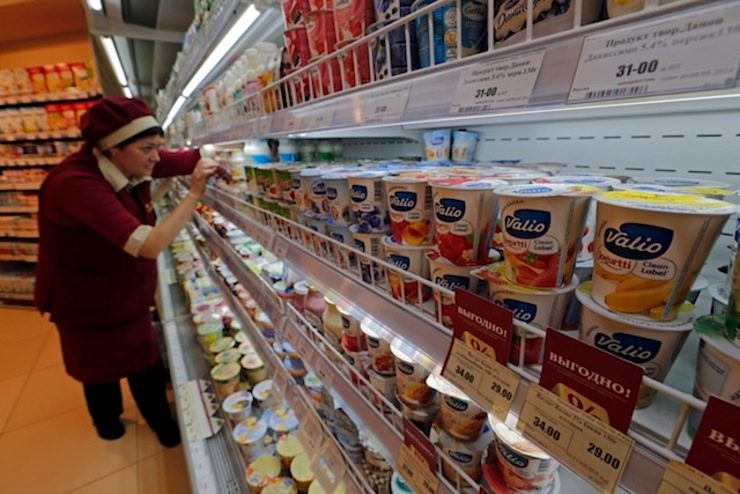SUMMARY
This is AI generated summarization, which may have errors. For context, always refer to the full article.

MOSCOW, Russia – In a Moscow supermarket, the dairy section is piled with imported yoghurts – unlike the empty shelves in many other shops in the Russian capital – but the ‘best-before’ date has long expired on most of them.
“Our manager asked us to make sure the shelves aren’t empty,” said Kristina, an assistant in the dairy produce section. “But we no longer receive deliveries of yoghurts from Europe and the United States and so we’re forced to cheat.”
“If customers buy an expired yoghurt, we warn them at checkout and they go back to look for a fresh one,” she added.
The shortages stem from the Kremlin’s move in early August to ban food imports from the Western countries that imposed sanctions on Russia over its role in the Ukraine crisis.
Since then, the contents of Russians’ shopping baskets have changed markedly.
Forty-year-old Veronika, a supermarket customer, misses her favorite French cheeses, which have been replaced by Russian brands.
But she adds, “I’ve already got used to it and am happy to buy local products as I am helping my country.”
The head of the Franco-Russian Chamber of Commerce and Industry, Pavel Shinsky, said that “the sanctions rather reveal a mood: Russia wants to show that it is self-sufficient, that it does not need Europe”.
As a result, “the impact is mostly felt by those foreign companies which have not located their production in Russia,” he added.
Many of them – such as French cheese producer Bongrain or foie gras supplier Rougie – were forced out of the Russian market after the embargo was enforced.
Others, like Russian company Le Maree, the number one importer of seafood to Russia, have managed to limit the damage by replacing their European and US suppliers with South American and Asian firms.
Higher prices, lower quality
“As we work with 25 countries, we were able to quickly refocus and fill the gap created by the embargo,” said Le Maree’s executive director Azamat Yusupov.
The 10 tons of French oysters that used to be imported every week before the embargo have been replaced with oysters from Russia’s Far Eastern Primorye and Sakhalin regions. The famous Kamchatka crab – previously imported from Norway – is now being supplied by local companies.
“But we are seeing an undeniable rise in prices because the market re-orientation requires new logistics and higher transport expenses,” said Yusupov, adding that the spiraling fall of the Russian ruble versus the dollar also affected prices.
Other problems are that the Russian food suppliers’ limited capacities cannot meet demand and the bid to replace foreign producers with local ones could lead to lower quality.
“The embargo forces us to opt for lower quality,” said Herve Michel whose Mlle Kashtan company sells roast chestnuts in Russia. “Our company promotes French culture and the falling quality does not correspond to the image of France we want to convey.”
But Yusupov said he was optimistic that even if the embargo’s short-term impact was negative, it would prove beneficial when the ban is lifted in a year.
“Once the embargo is lifted, all our old producers will be back on the market, while Russian products will have improved their quality. This will lead to healthy competition, a wider choice for consumers,” he said. – Rappler.com
Add a comment
How does this make you feel?


![[In This Economy] Can the PH become an upper-middle income country within this lifetime?](https://www.rappler.com/tachyon/2024/04/tl-ph-upper-income-country-04052024.jpg?resize=257%2C257&crop=295px%2C0px%2C720px%2C720px)


There are no comments yet. Add your comment to start the conversation.